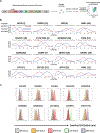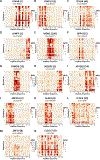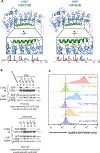Elucidation of E3 ubiquitin ligase specificity through proteome-wide internal degron mapping
- PMID: 37738965
- PMCID: PMC10594193
- DOI: 10.1016/j.molcel.2023.08.022
Elucidation of E3 ubiquitin ligase specificity through proteome-wide internal degron mapping
Erratum in
-
Elucidation of E3 ubiquitin ligase specificity through proteome-wide internal degron mapping.Mol Cell. 2023 Nov 16;83(22):4191-4192. doi: 10.1016/j.molcel.2023.10.021. Epub 2023 Nov 16. Mol Cell. 2023. PMID: 37977122 Free PMC article. No abstract available.
Abstract
The ubiquitin-proteasome system plays a critical role in biology by regulating protein degradation. Despite their importance, precise recognition specificity is known for a few of the 600 E3s. Here, we establish a two-pronged strategy for identifying and mapping critical residues of internal degrons on a proteome-scale in HEK-293T cells. We employ global protein stability profiling combined with machine learning to identify 15,800 peptides likely to contain sequence-dependent degrons. We combine this with scanning mutagenesis to define critical residues for over 5,000 predicted degrons. Focusing on Cullin-RING ligase degrons, we generated mutational fingerprints for 219 degrons and developed DegronID, a computational algorithm enabling the clustering of degron peptides with similar motifs. CRISPR analysis enabled the discovery of E3-degron pairs, of which we uncovered 16 pairs that revealed extensive degron variability and structural determinants. We provide the visualization of these data on the public DegronID data browser as a resource for future exploration.
Keywords: Alphafold2; CRL; Cullin-RING ligase; DegronID; E3 ubiquitin ligase; GPS; degron; global protein stability; protein degradation; ubiquitination.
Copyright © 2023 The Authors. Published by Elsevier Inc. All rights reserved.
Conflict of interest statement
Declaration of interests S.J.E. is a founder of TSCAN Therapeutics, MAZE Therapeutics, ImmuneID and Mirimus; serves on the scientific advisory boards of Homology Medicines, ImmuneID, MAZE Therapeutics, and TSCAN Therapeutics; is an advisor for MPM Capital; and is on the Editorial Board for Molecular Cell. None of this affects this work.
Figures







References
-
- Li W, Bengtson MH, Ulbrich A, Matsuda A, Reddy VA, Orth A, Chanda SK, Batalov S, and Joazeiro CAP (2008). Genome-Wide and Functional Annotation of Human E3 Ubiquitin Ligases Identifies MULAN, a Mitochondrial E3 that Regulates the Organelle’s Dynamics and Signaling. PLoS One 3, e1487. 10.1371/JOURNAL.PONE.0001487. - DOI - PMC - PubMed
Publication types
MeSH terms
Substances
Grants and funding
LinkOut - more resources
Full Text Sources
Molecular Biology Databases
Miscellaneous

